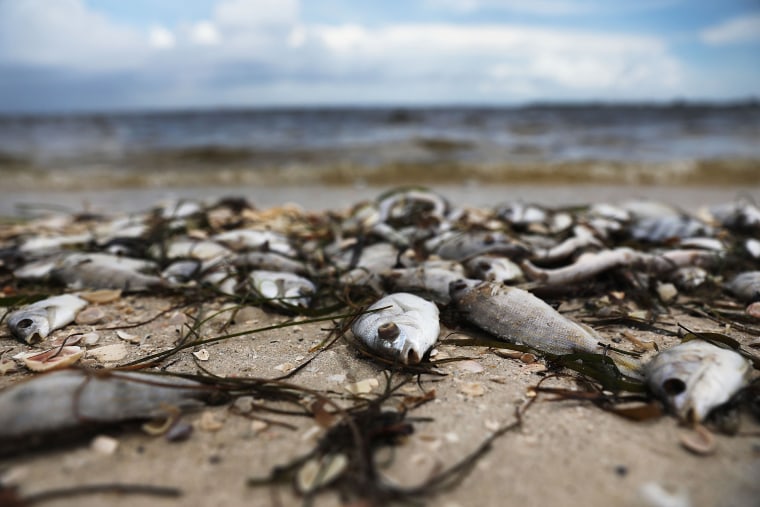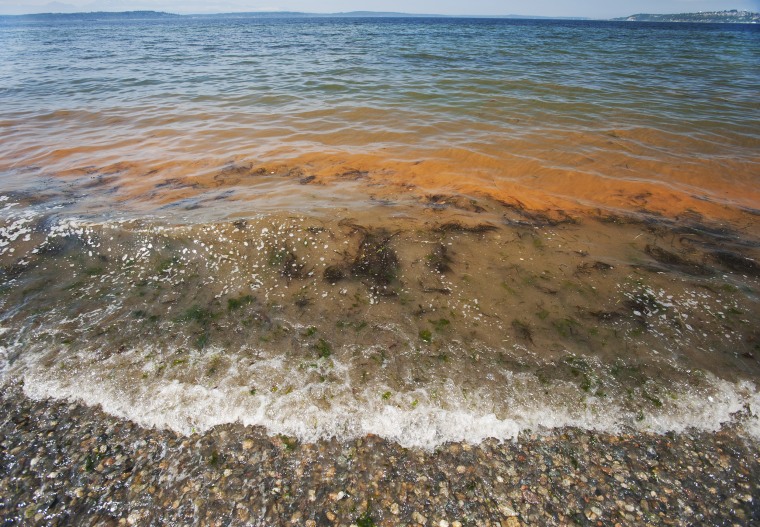A red tide is a dangerous overgrowth of microscopic marine plants known as algae. The overgrowth — there can be millions of algae per gallon of seawater — can turn coastal waters bright red and release toxins that harm marine life, birds and humans. Red tides can cause breathing problems in beachgoers, and people can be poisoned by eating fish and shellfish taken from affected waters.
Though “red tide” is the common term for the phenomenon, many scientists prefer “harmful algal bloom,” or HAB. Not all HABs cause water to turn red, however. An algal bloom of luminous blue was recently seen along the coasts of Taiwan.
Red tides are nothing new. The earliest reports of red tides are from Japan in the 8th century. Spanish explorers heard stories of “red water” from Florida Indians in the 16th century.
Where do red tides occur?
Red tides occur in coastal waters all over the world. In the United States, they are common along the Texas coast, and they occur almost every summer along the Gulf Coast of Florida. They’re also common along the coast of California and in the Gulf of Maine.
What causes red tides?
In Florida and Texas, red tides are caused by an alga called Karenia brevis. But algal blooms can be caused by many different species of algae.
Thomas Frankovich, a Florida International University biologist who studies algal blooms around Key Largo, Florida, says red tides occur when water temperatures are high. “They seem to start up in the late summer, then they persist for about four months into late fall, and then they die back,” he says of red tides in Florida. “But a lot of times they persist throughout the entire year and make the next year's bloom even larger.”

In addition to warm waters, Frankovich says red tides are fueled by naturally occurring upwellings of nutrient-rich water. Algal blooms can be worsened by fertilizer runoff from farming and waste from sewage treatment plants, but Frankovich says that doesn’t seem to be the case with red tides in Florida.
What are the effects of red tides?
The algae that cause red tides in Florida produce brevetoxins, which attack the nervous systems of fish, shellfish and birds as well as humans and other mammals. Similar toxins can be produced by other algal blooms.
Over a period of weeks, red tide toxins can wipe out populations of fish and shellfish and kill large numbers of sea turtles and even some bigger animals such as manatees and dolphins. Seabirds can die from breathing in algal toxins or eating contaminated fish. Their feathers can be damaged by a surface foam created by the algae.
As the algae die and decompose, seawater can become depleted of oxygen, resulting in a “dead zone” that can add to the death toll of sea life.
Given the risks red tides pose to people, authorities typically close beaches during algal blooms and stop commercial fishing in affected areas. Such precautions come with a cost: The National Oceanic and Atmospheric Administration estimates that economic losses to the tourist, seafood and restaurant industries can run up to $82 million a year.
What precautions should be taken during red tides?
The NOAA’s National Ocean Service maintains a website that forecasts red tides. Florida’s Fish and Wildlife Conservation Commission keeps watch on red tides around the state on its own website.
When a red tide strikes, local authorities often post written warnings at beaches and marinas, and restaurants take off the menu fish and shellfish that could be affected. But beachgoers should be aware that red tides can affect coastal areas in late summer and early fall and they should be vigilant about what they eat and when and where they go to the beach.
Swimmers who may inadvertently have been exposed to affected water should rinse off with fresh water, and the same goes for pets that may have been exposed.
Common symptoms of red tide poisoning include breathing problems, tingling sensations, rapid heartbeat and problems with coordination. Anyone who experiences these symptoms after eating seafood or going near the ocean should seek immediate medical treatment.
Want more stories about science?
- Deep inside Earth, scientists find weird blobs and mountains taller than Mount Everest
- Immense crater may have been found deep under Greenland's ice sheet
- This floating city concept is one way to cope with climate change
SIGN UP FOR THE MACH NEWSLETTER AND FOLLOW NBC NEWS MACH ON TWITTER, FACEBOOK, AND INSTAGRAM.

